Schwalm Band (1) – Design Transfer
I gave up my original plan to embroider on industrially woven striped linen. Instead I used 17/16-15 count handwoven linen
and cut it to a size of 200 cm x 35 cm. The central longitudinal axis was marked along a fabric thread using short Running stitches with coloured sewing thread.
Now there are different types of design transfer – using an iron-on pen, tracing using blue paper, pricking with the help of blue paper, on a light pad with heat- or water-soluble pens (they are also available from companies other than those mentioned here). I have now worked a lot with the last-mentioned pens and have given up my initial reservations about them.
Each version has advantages and disadvantages. What’s nice about the last-mentioned pens is that they don’t fade while you’re working and are easy to wash out later. However, you have to draw directly on the linen. The pin jumps a little due to the unevenness between the threads and the spaces between the threads.
But since the old, hand-woven, very heavy linen was not translucent enough for a light print – the template was clear and significant, but the light was not bright enough –
I decided to iron on the pattern and used my DEKA pen. With previous, smaller iron-on design transfers I had noticed that the colour was difficult to separate from the paper and was therefore only transferred weakly to the linen. So I first carried out tests with different papers. The cheapest, thin greaseproof paper worked best,
The colour stuck to the architect’s paper too tightly. It is also important to have a very hot iron. For such purposes I have an old iron that heats up to high heat.
I found the greaseproof paper in roll form with a width of 25 cm – ideal for my project. The pattern was then transferred in different sections that were not too long.
If the ironing patterns are short, you don’t need a special base, the positioning is easier and it is much easier to check whether the patterns have been completely transferred.
In order not to let the lines become too wide, the iron-on pattern pencil often had to be sharpened. With the right sharpener it worked perfectly. The mine didn’t even break off. Nevertheless, the new pen lost approximately 5 cm of its initial length of 17.5 cm during the drawing of the elaborate pattern.
In order to be able to transfer the pattern on the ironing board, I always just flattened the part of the linen that was supposed to receive the design. The remaining piece was rolled up.
The crucial step began with the iron heated to the highest setting, the ironing board well preheated, the linen straightened and ironed over to preheat, the pattern positioned correctly and secured with a few pins. I started ironing on the right side. The iron must never be lifted during the process, only moved. After some time of ironing, I moved the iron slightly to the left, removed the right pins and lifted the paper slightly and carefully to check that all the lines were transferred clearly. If this was not the case, the iron was pushed back into its previous position and the paper with the coöour was heated for longer. At times I felt like the linen was scorching, but it only turned slightly brown. So I worked my way to the left little by little until the prepared section of the pattern was completely transferred. The finished part was rolled up and the next section was prepared.
This way the entire motif border was ironed on piece by piece until the long ribbon was in front of me in all its beauty. The scorched areas are hardly noticeable anymore, the pattern is clear but not excessively applied.
Thereby I invested the first four hours in the project – my careful work was worth it.
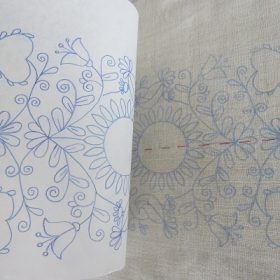
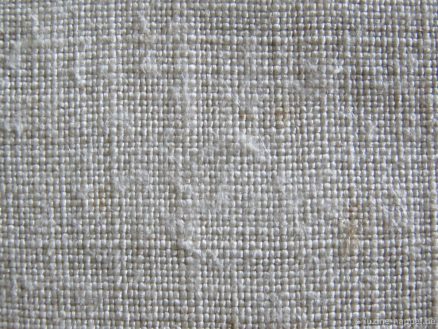
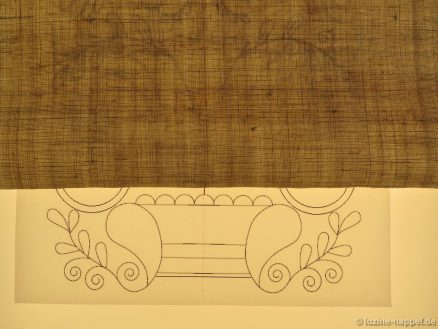
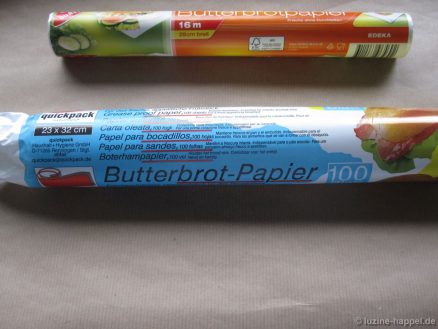
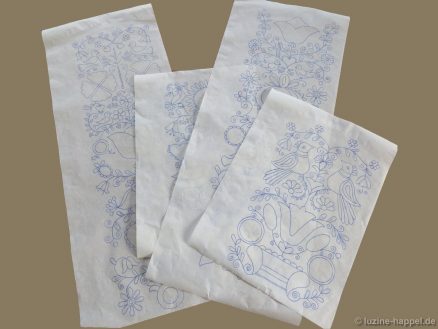
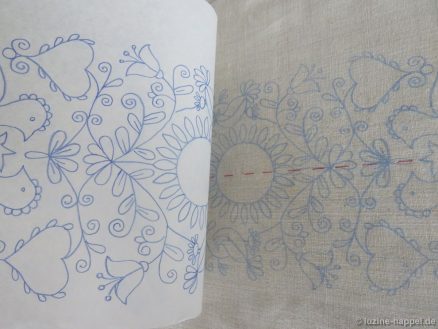
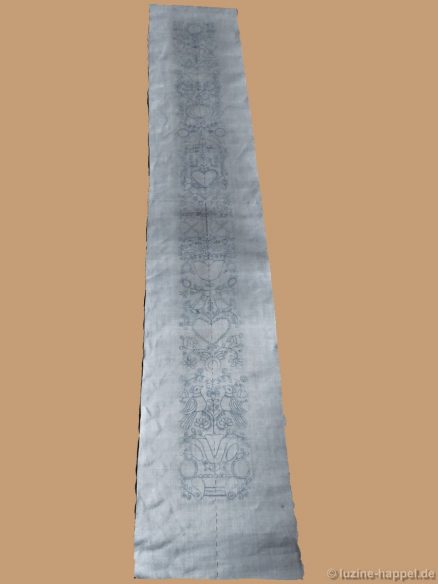


Liebe Frau Happel,
herzlichen Dank für Ihre ausfühlriche Darstellung der verschiedenen Möglichkeiten von Musterübertragungen. Ich habe mit einem alten Bügelmusterstift von Prym von Butterbrotpaoier auf weißes Weddigen Leinen 160 gebügelt. Ich musste das Eisen recht lange (ca. 12 Sekunden) auf das Papier halten, damit sich der Stift überhaupt löste. Dabei hat sich das Leinen ganz leicht gebräunt. Geht diese Bräunung beim Waschen wieder raus? – Ich überlege, auch weil das Muster, welches ich übertragen möchte ca. 60 cm lang und an seiner breitesten Stelle 23 cm breit ist, mit dem von Ihnen empfohlenen Handdurchschreibepapier von Kores zu arbeiten.
Die leichte Bräunung geht beim Waschen wieder heraus. Nicht das Leinen selbst ist angesengt. Die Sengspuren sind auf dem Ausrüstmaterial, das auf die Oberfläche des Leinens aufgebracht wurde.
Haben Sie Bügelunterlage und Leinen vorgewärmt, bevor Sie das Muster übertragen haben? Wenn der Stoff schon warm ist, braucht es nicht so lange, bis sich der Stift vom Papier löst.
Meine Tests mit dem Durchpausen bezogen sich auf pflegeleichtes Leinen. Ich habe festgestellt, dass bei diesem Leinen auch aufgedruckte Linien sehr viel leichter auszuwaschen sind.